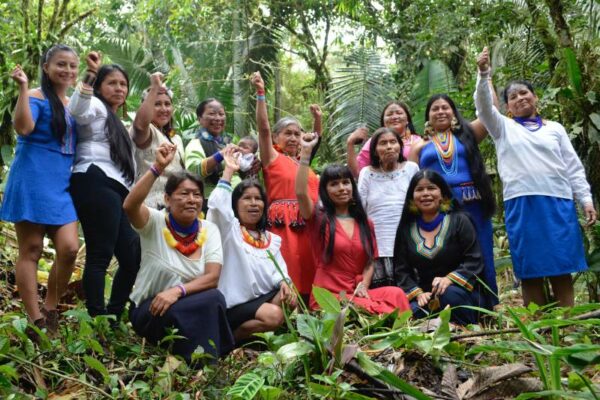* The Bahuaja Sonene Nacional Park, where the Tambopata Candamo River Basin is located, was declared one of the world’s seven iconic sanctuaries.
* Free Trade Agreement with the US could be endangered by measure.
Press Contacts
Luis Eduardo Cisneros: 422 2720/ 9371 4481
Giannina Da Roit: 225 5008/ 9739 5568
Mariella Laos: 422 2720/ 9714 5564
Representatives of numerous Peruvian and international organizations are deeply concerned about the effects of a legal amendment proposed to the Ministers Council on September 25, 2007. The amendment aims to reduce the Bahuaja Sonene National Park by 209,000 hectares (516,000 acres) and open it to oil and gas exploration. The area at risk is an uninhabited and pristine tract of rainforest in the Candamo and Tambopata basins, home to record numbers of plant and animal species.
If the Peruvian Congress approves this amendment, one of the world’s most biologically diverse and intact rainforests will be threatened. In political realms, Peru’s significant progress towards signing a Free Trade Agreement with the United Status will also be at risk.
Candamo is a rainforest wilderness of globally recognized conservation importance and beauty. It is an area of the Bahuaja National Park that has been classified as a “strictly protected zone” because it is both extremely vulnerable and unique in the world. Without Candamo, the huge Tambopata Candamo National Reserve / Bahuaja Sonene National Park complex will lose the very impetus of their creation as protected areas.
The Bahuaja Sonene Park comprises 1,092,142 hectares of lowland and montane rainforest. The National Geographic Society declared it one of the world’s seven “iconic natural sanctuaries.” It was set aside as a park because it is one of the planet’s most intact rainforests and it is a sanctuary for unprecedented numbers of species and natural habitats. It is a land of tapirs, jaguars, peccaries, and macaws—many of which are practically tame, as the area has not been hunted in decades
The park is part of vast continuum of protected areas, including the adjacent Tambopata National Reserve, one of Peru’s main natural tourism attractions, and Madidi National Park, directly across the border in Bolivia. Both protect the headwaters of the Madeira River, the most extensive tributary of the Amazon. The park is also vital to the well being of over 50,000 inhabitants in Puerto Maldonado and the surrounding indigenous and ribereno communities who depend on the purity of the water and the rich sediment it carries from the Andes down through Candamo’s uninhabited basin. That is another fundamental reason for its strictly protected status.
The proposal to reduce the size of the National Park undermines our legal environmental framework. The Peruvian State is legally mandated to promote the conservation of national protected areas, as stated in Article 68 of Peru’s constitution. Furthermore, Peru has subscribed the Convention on Biological Diversity, which commits member states to strengthening protected areas.
The proposed amendment threatens the approval of the Free Trade Agreement that is being negotiated between the governments of Peru and the United States. It directly contradicts some of the commitments established therein, such as article 18.3, paragraph 2, of Chapter 18 on the environment, which states it is inappropriate to promote commerce and investment by weakening or reducing protection contemplated in the environmental legislation of the sides. Finally, number 14, defines environmental legislation, as any law or regulation which has the principal purpose of protecting the environment or preventing threats to human, animal or plant life or wellbeing, through the conservation of wildlife, including endangered species, their habitat, and natural areas under special protection.
This document is suscribed by
Agencia de Noticias Ecopress
Asociación para la Conservación de la Cuenca Amazónica (ACCA)
Asociación Perú Verde
Asociación Peruana para la Conservación de la Naturaleza (APECO)
Asociación Peruana de Turismo de Aventura y Ecoturismo(APTAE)
Centro de Conservación, Investigación y Manejo de Áreas Naturales (CIMA)
Centro para la Sostenibilidad Ambiental de la UPCH
Comisión Ambiental Regional Lambayeque (CAR-L)
Coopera
CooperAcción
Conservación Internacional (C.I)
Conservación Internacional –Tambopata
Derecho, Ambiente y Recursos Naturales (DAR)
Fundación Cayetano Heredia
Instituto Conservación y Culturas (ICC)
Grupo Viajeros
Rainforest Expedition
Schubot Exotic Bird Health Center, Texas A&M University
Sociedad Hoteles del Perú
Sociedad Peruana de Botánica
Sociedad Peruana de Derecho Ambiental (SPDA)
Tambopata Macaw Project
Te quiero verde
World Wildlife Fund (WWF)
Martín Arana
César Aguilar Puntriano
Donald Brightsmith
Martha E. Campos Carmona
Víctor Chirinos Saavedra (*)
Loyola Escamilo
Fátima García
Javier F. Gordillo Jordán
Carmela Landeo Sanchez.
Joaquín Leguia
Rafael León
Cinthia L. Mongylardi Campos
Lucila Pautrat Oyarzún
Gabriel Quijandría
Natalia Quinteros Casaverde
Flor de María Robles Barreto
Jose Roque Gamarra
Heidi Rubio-Torgler
Manuel Vásquez Gálvez













